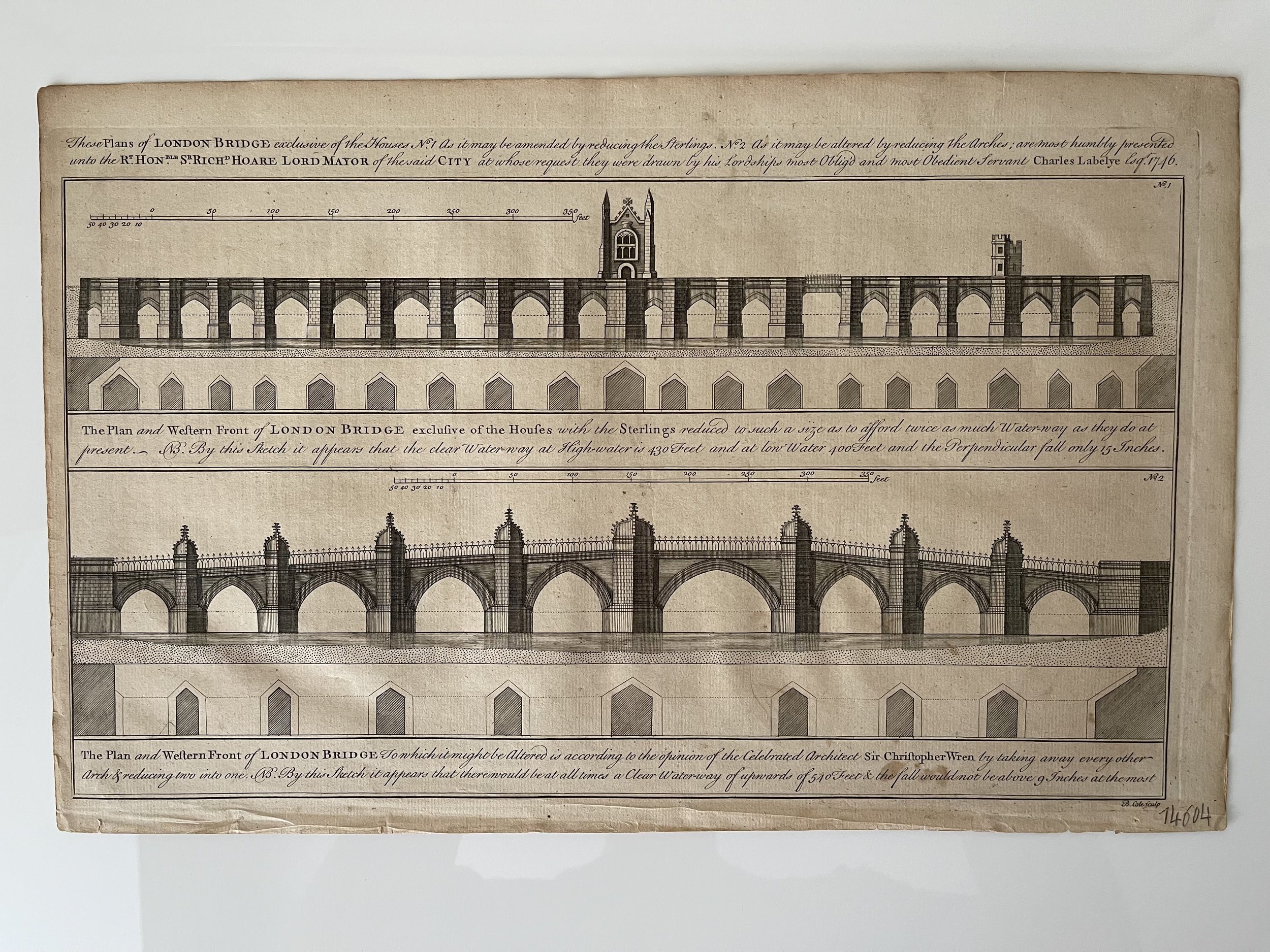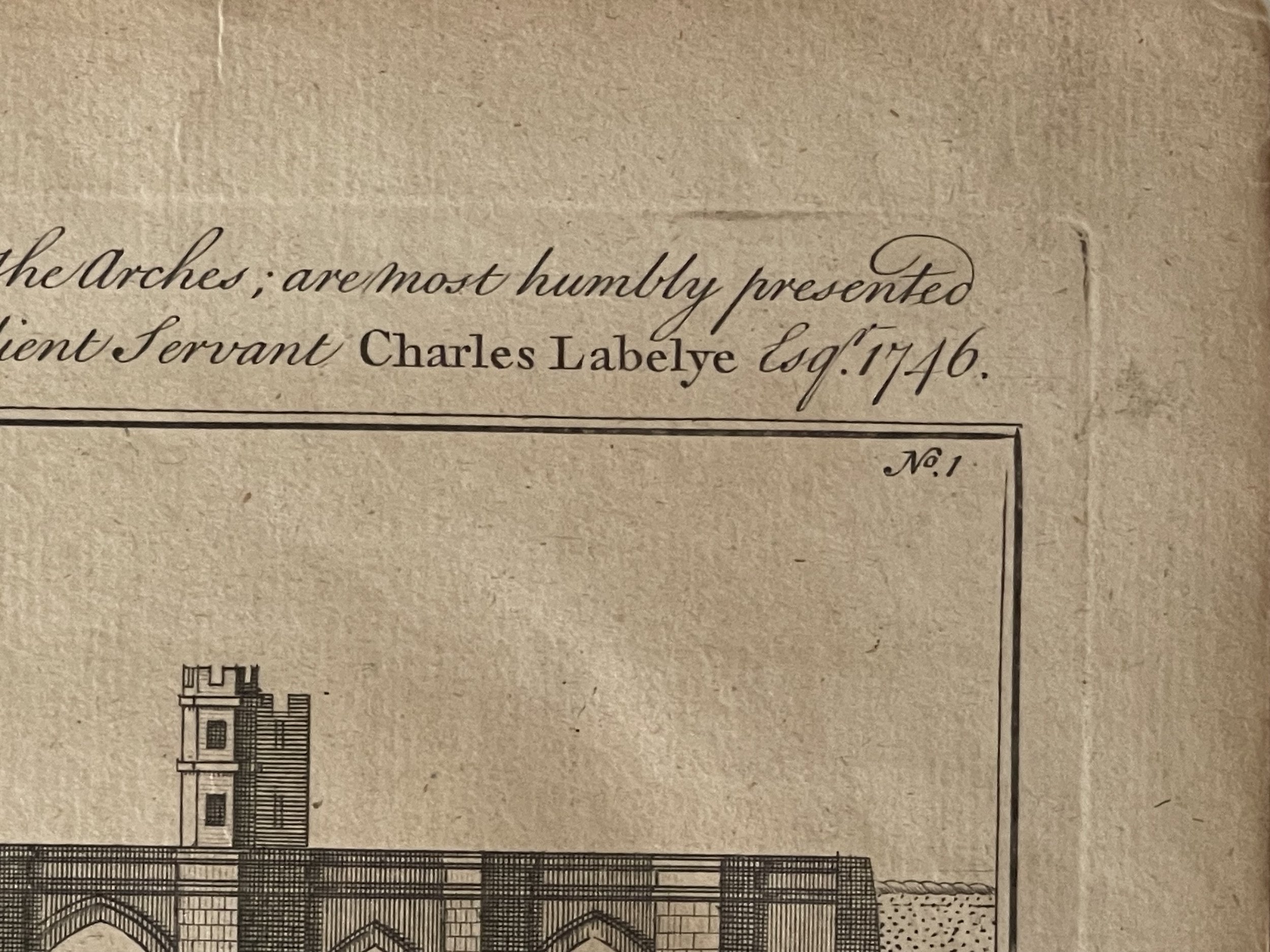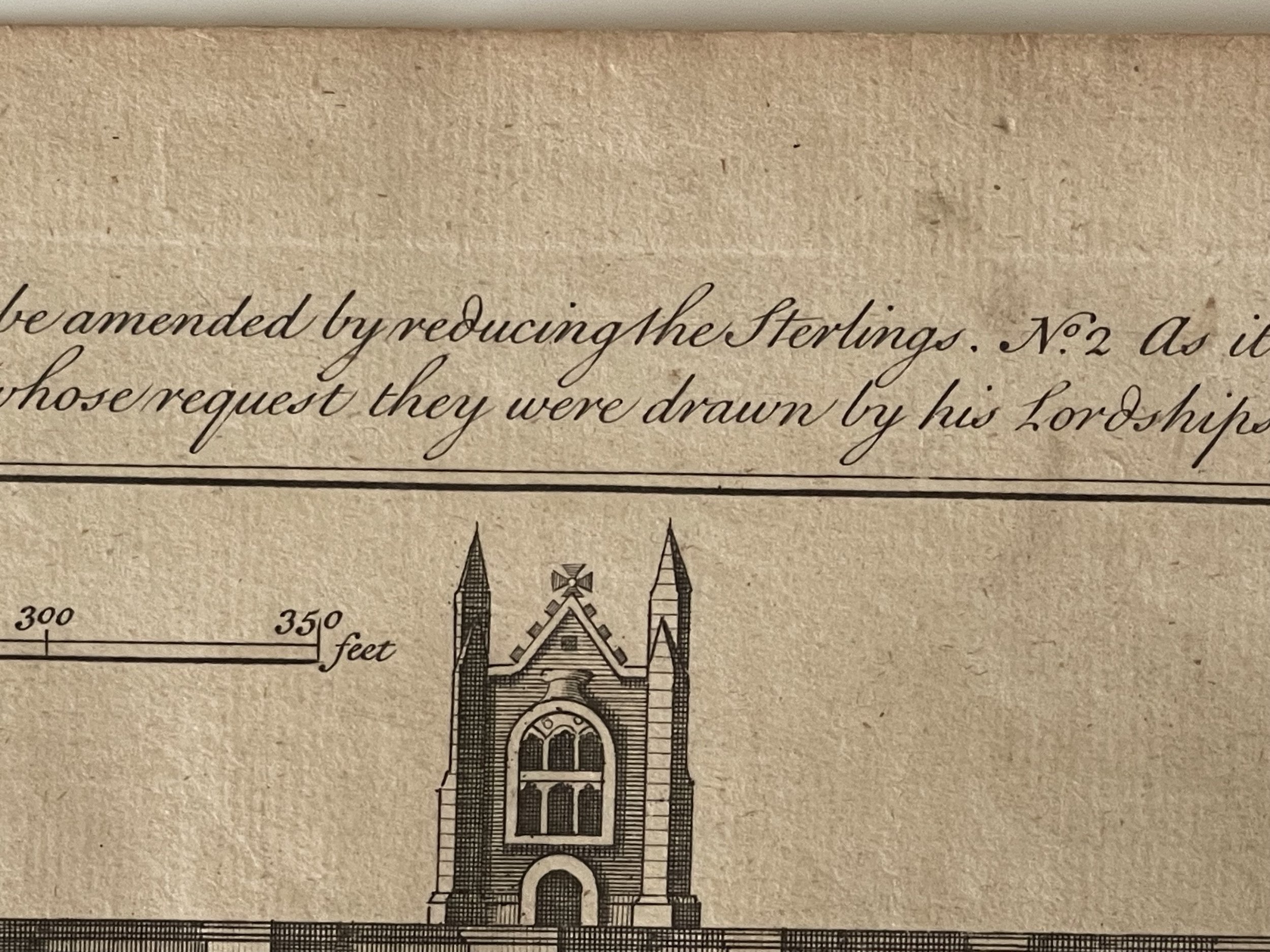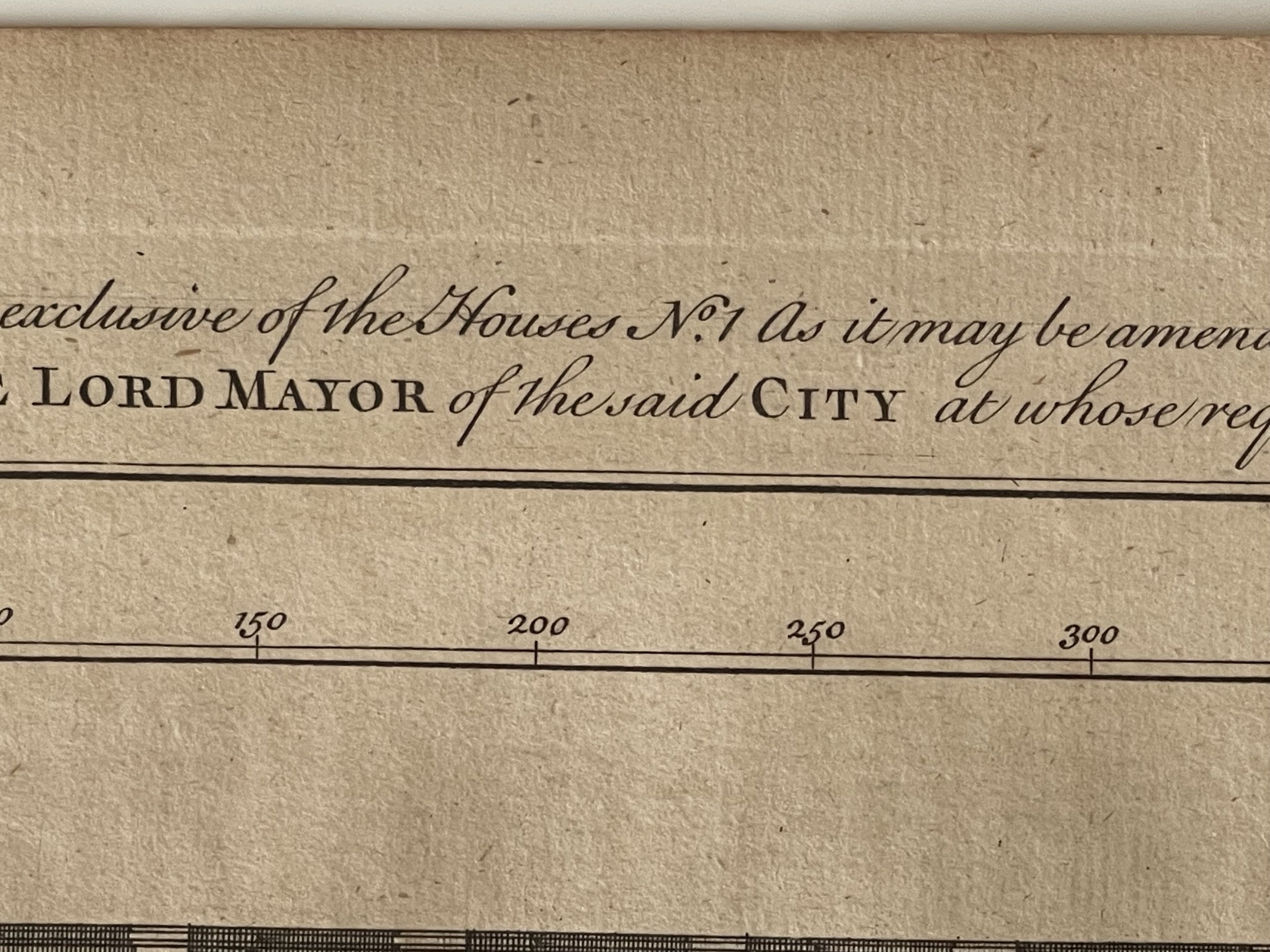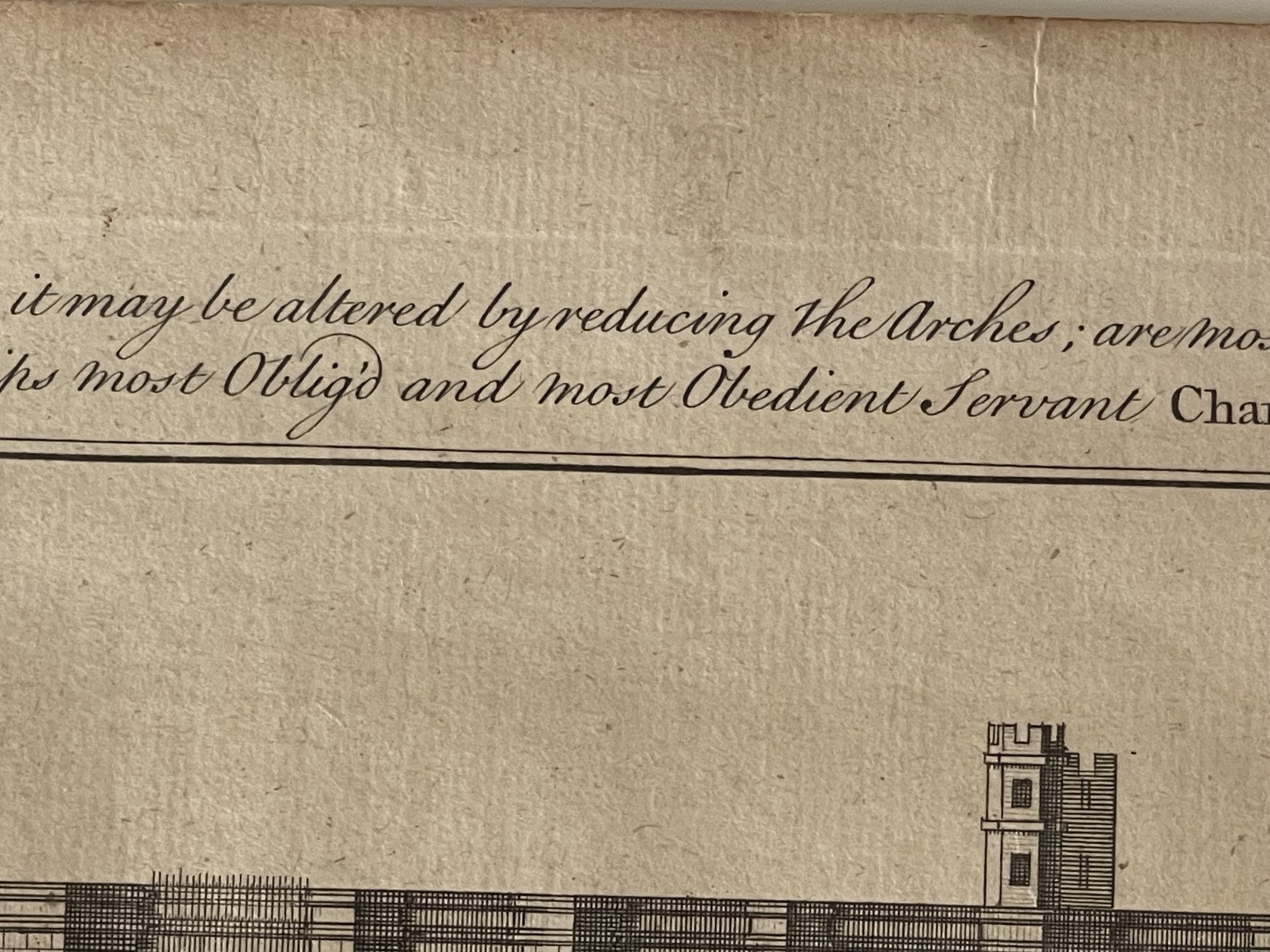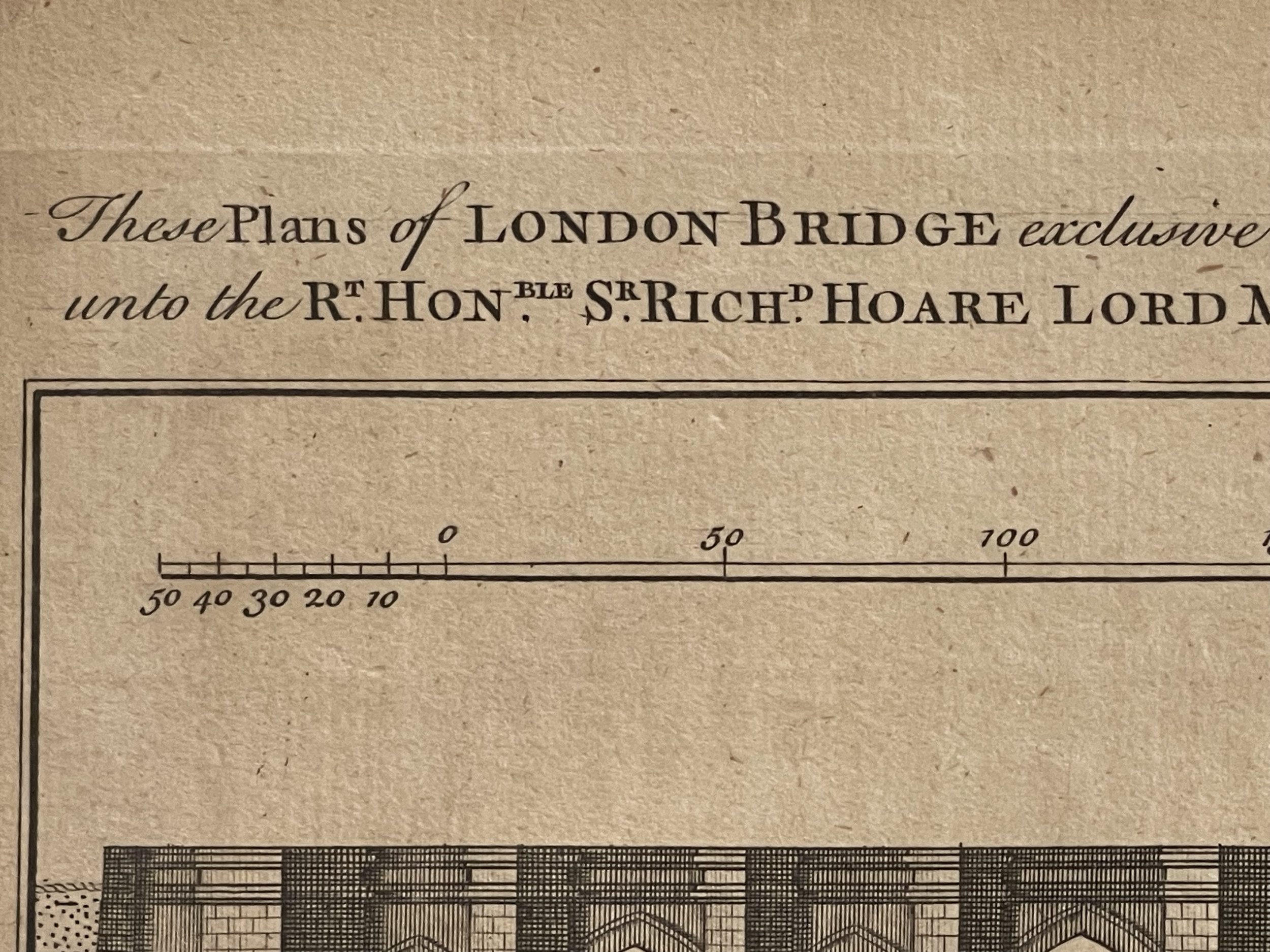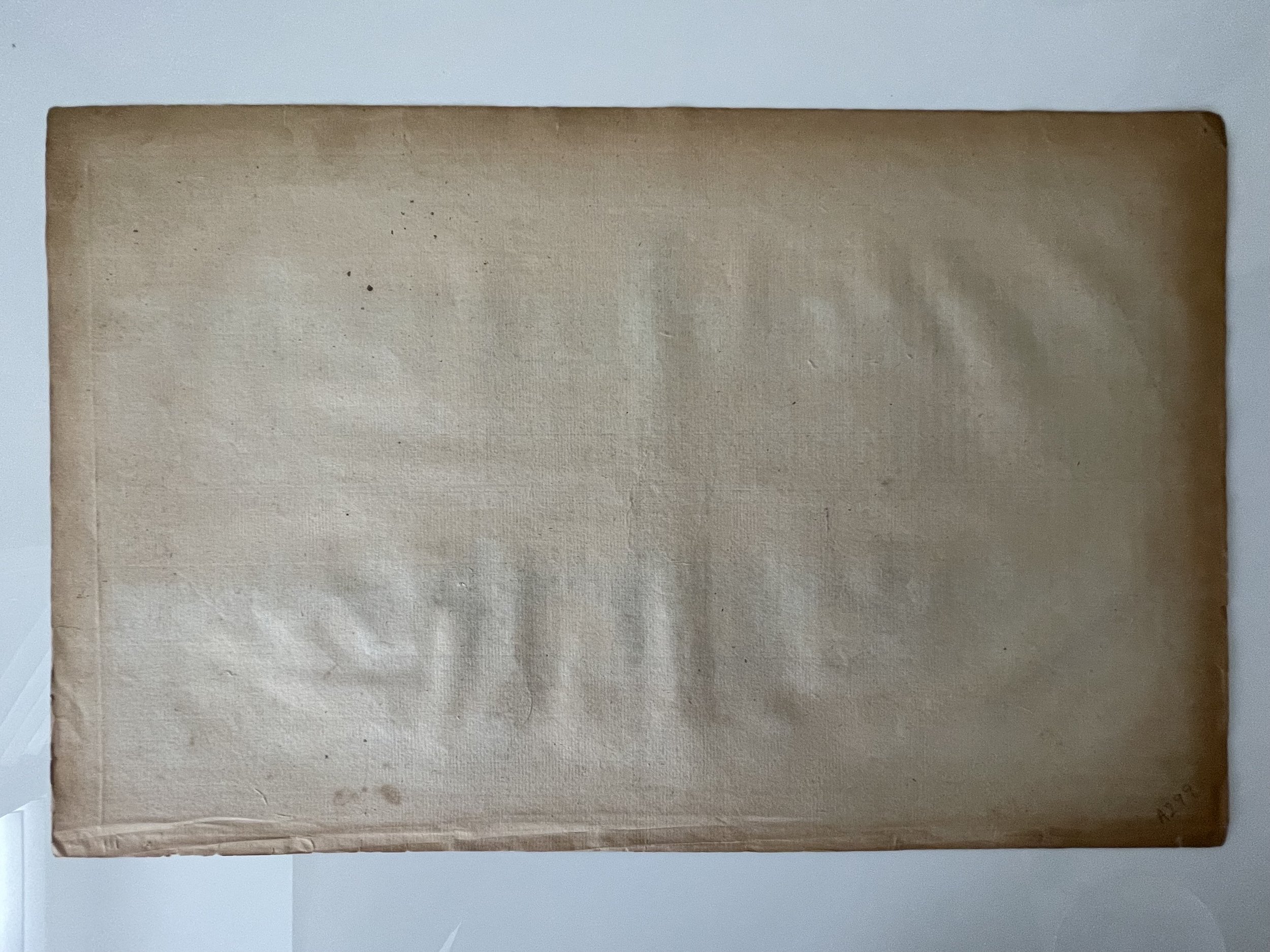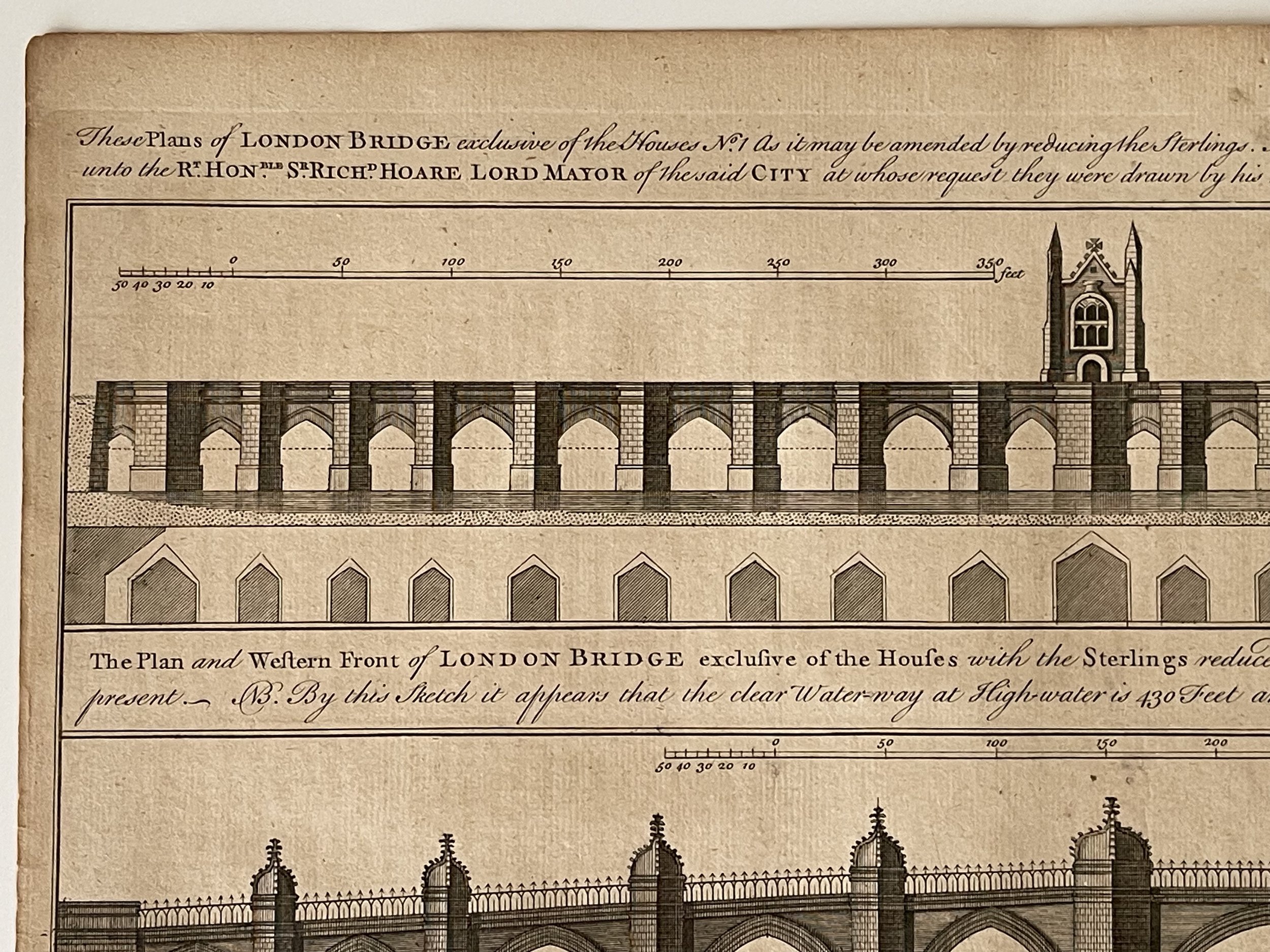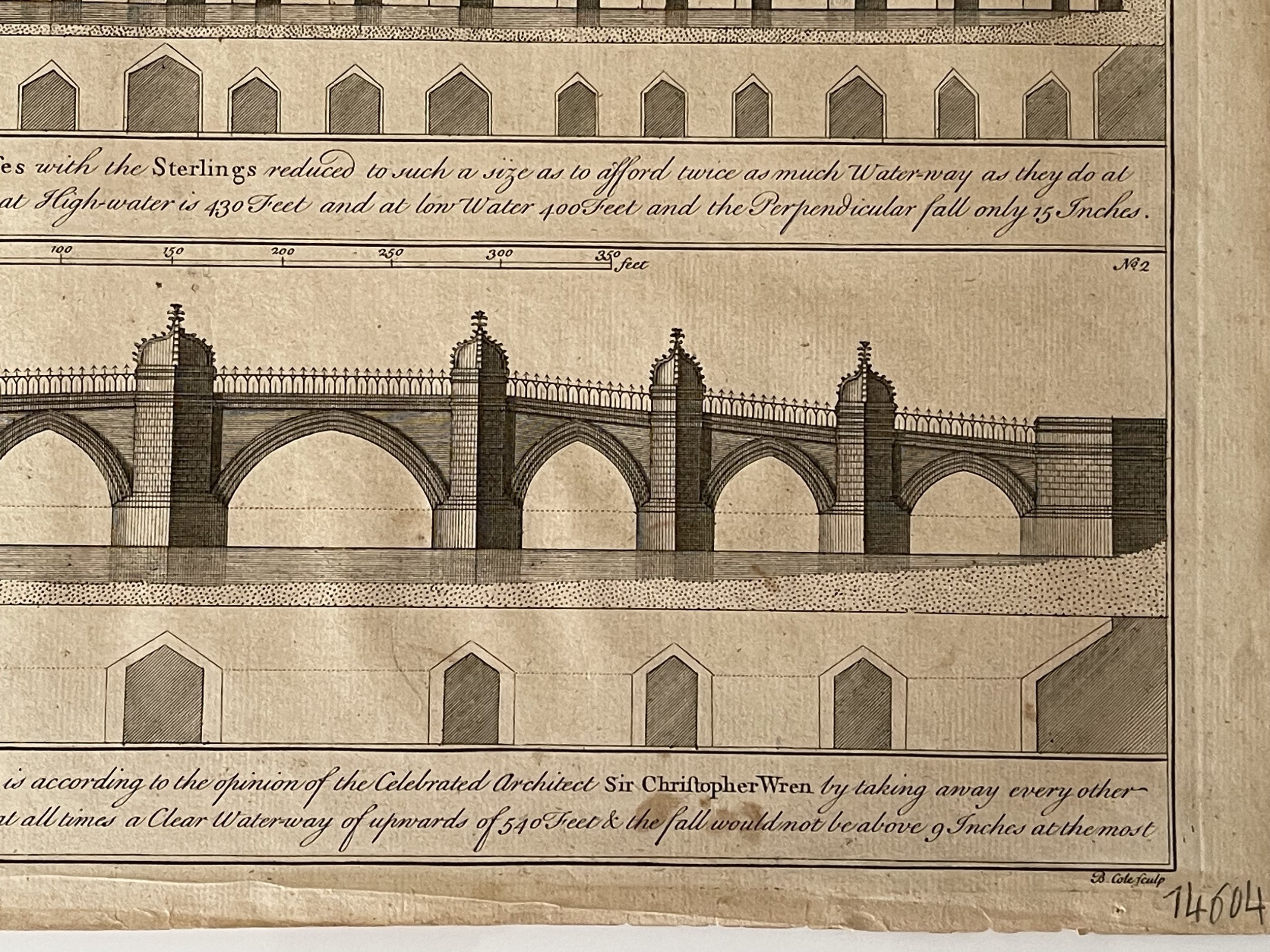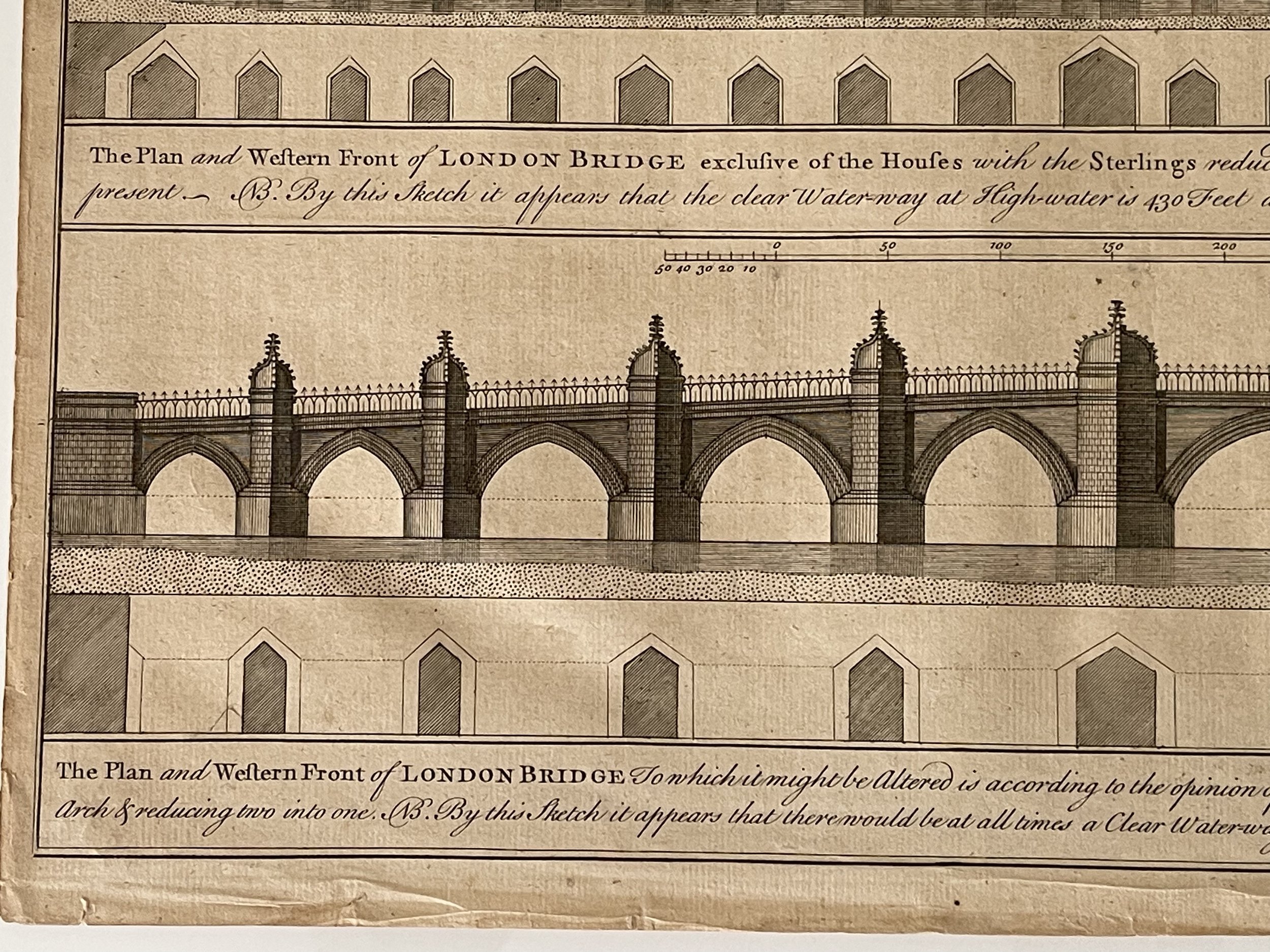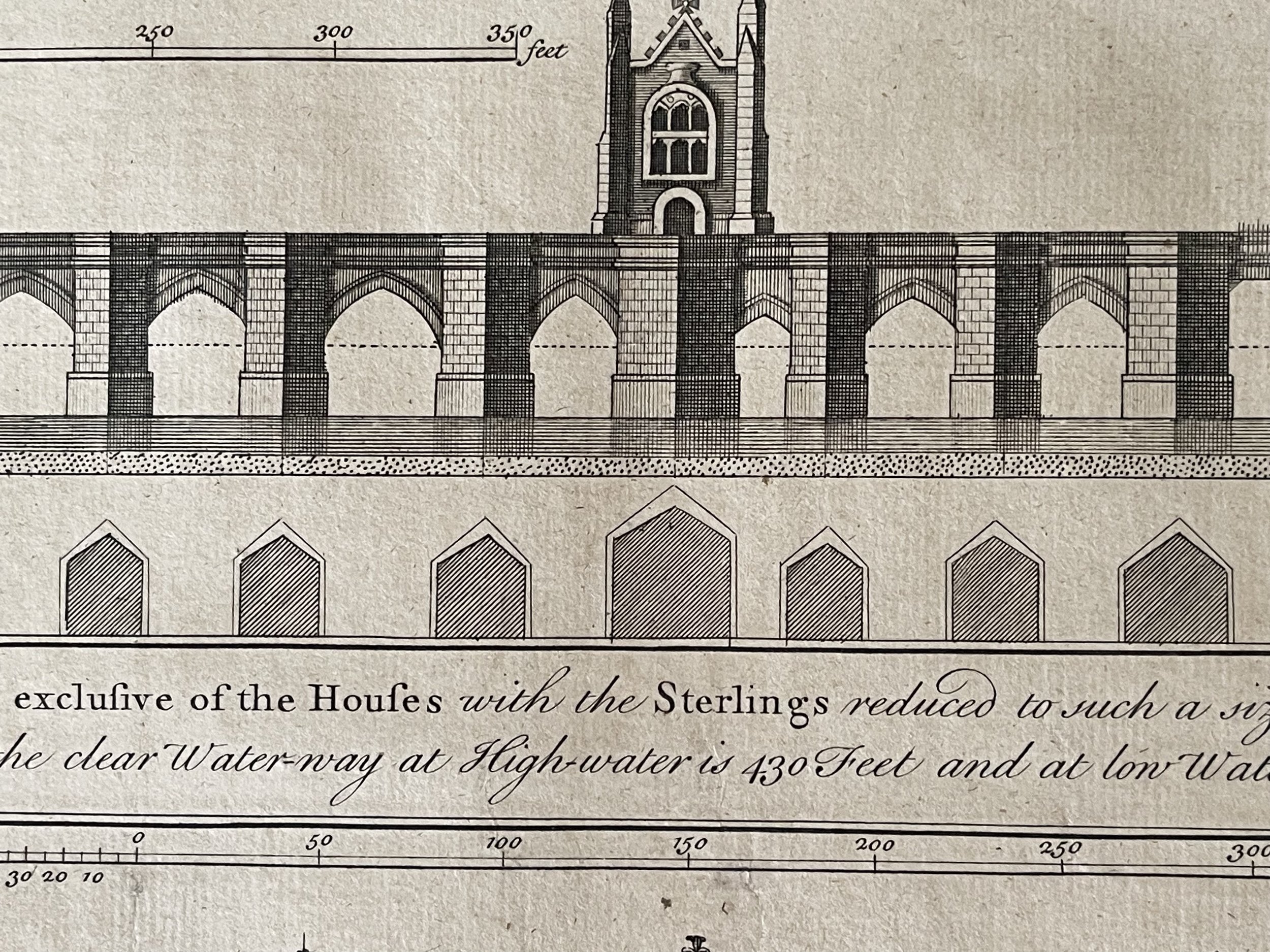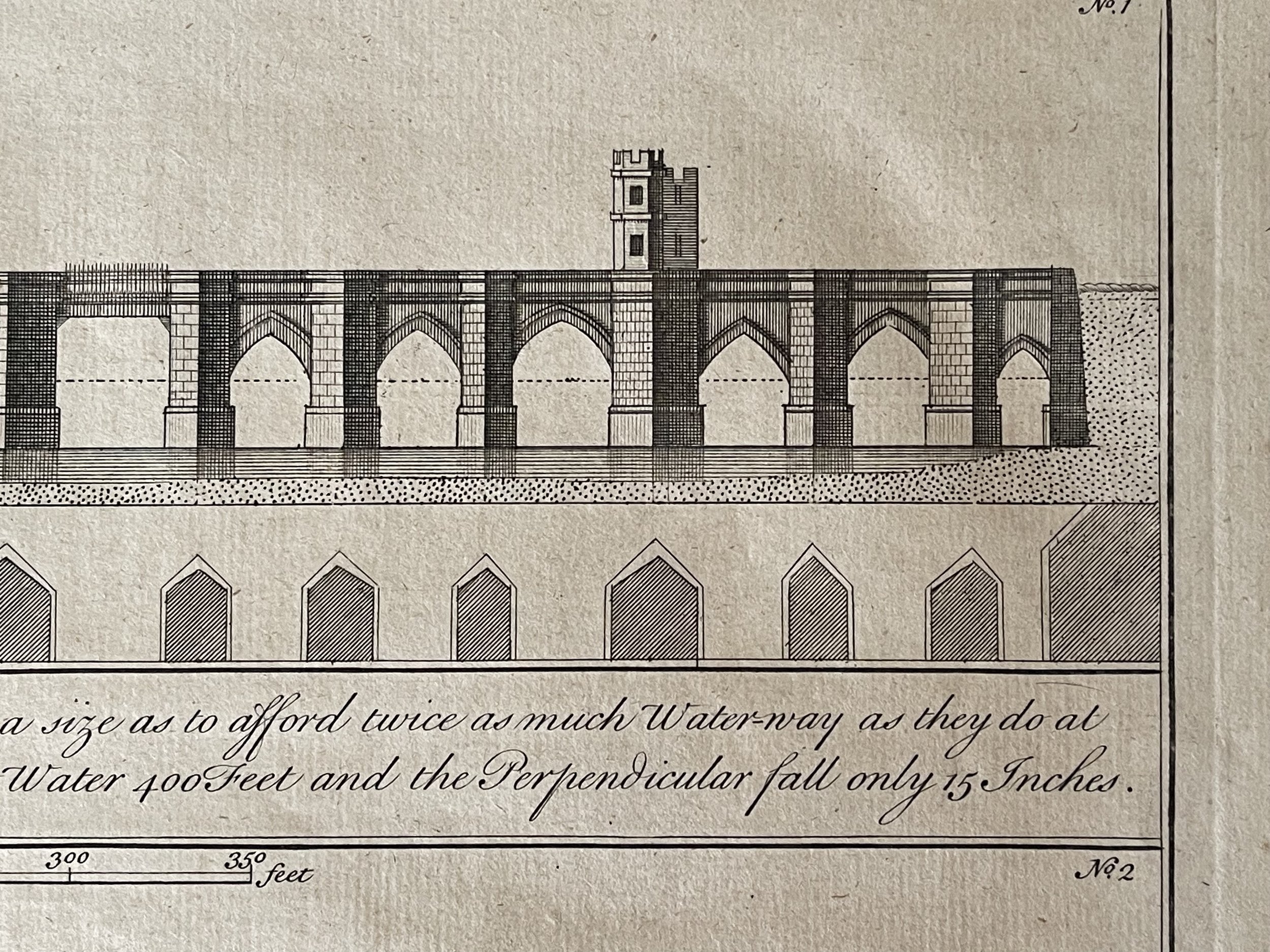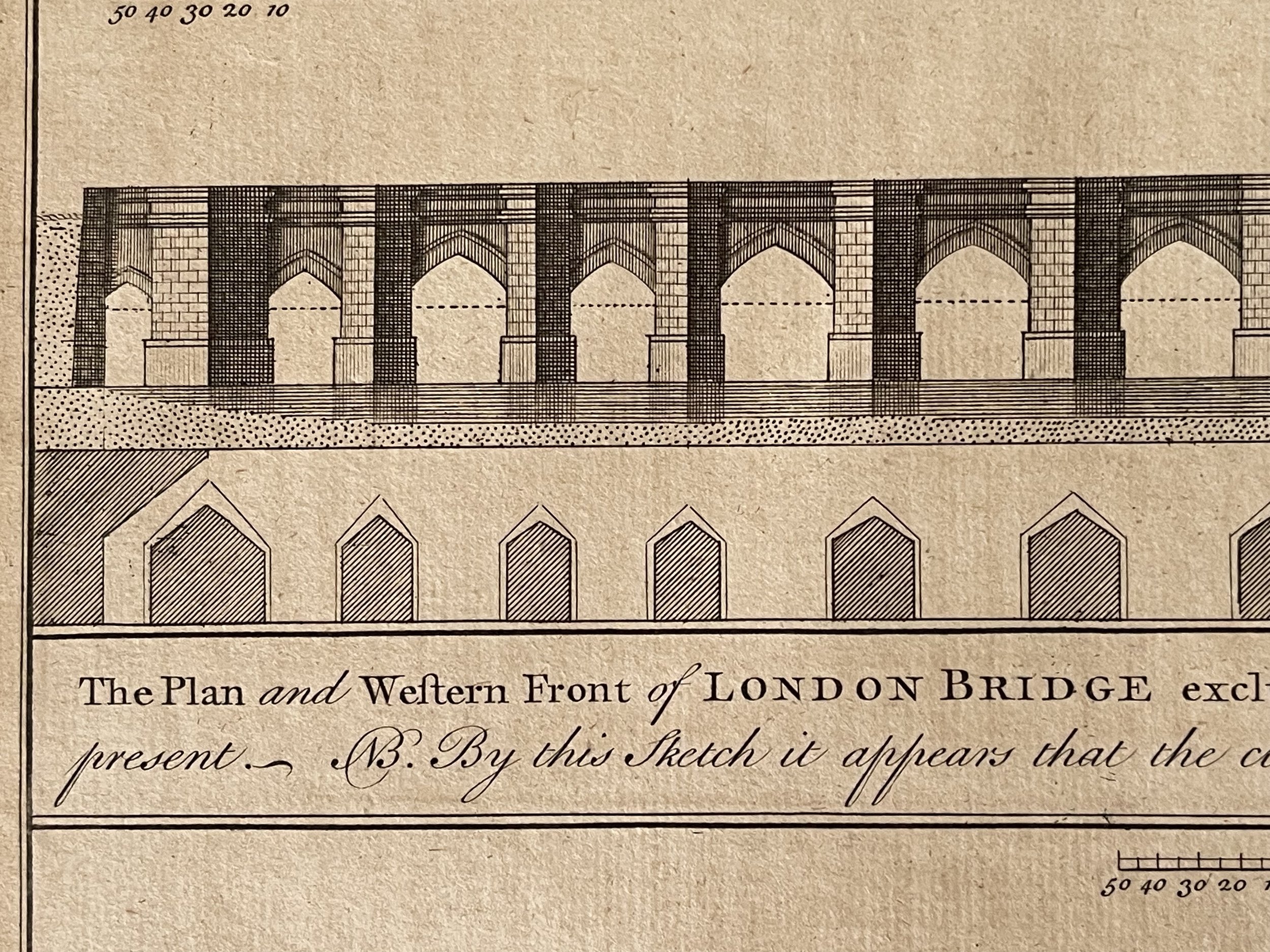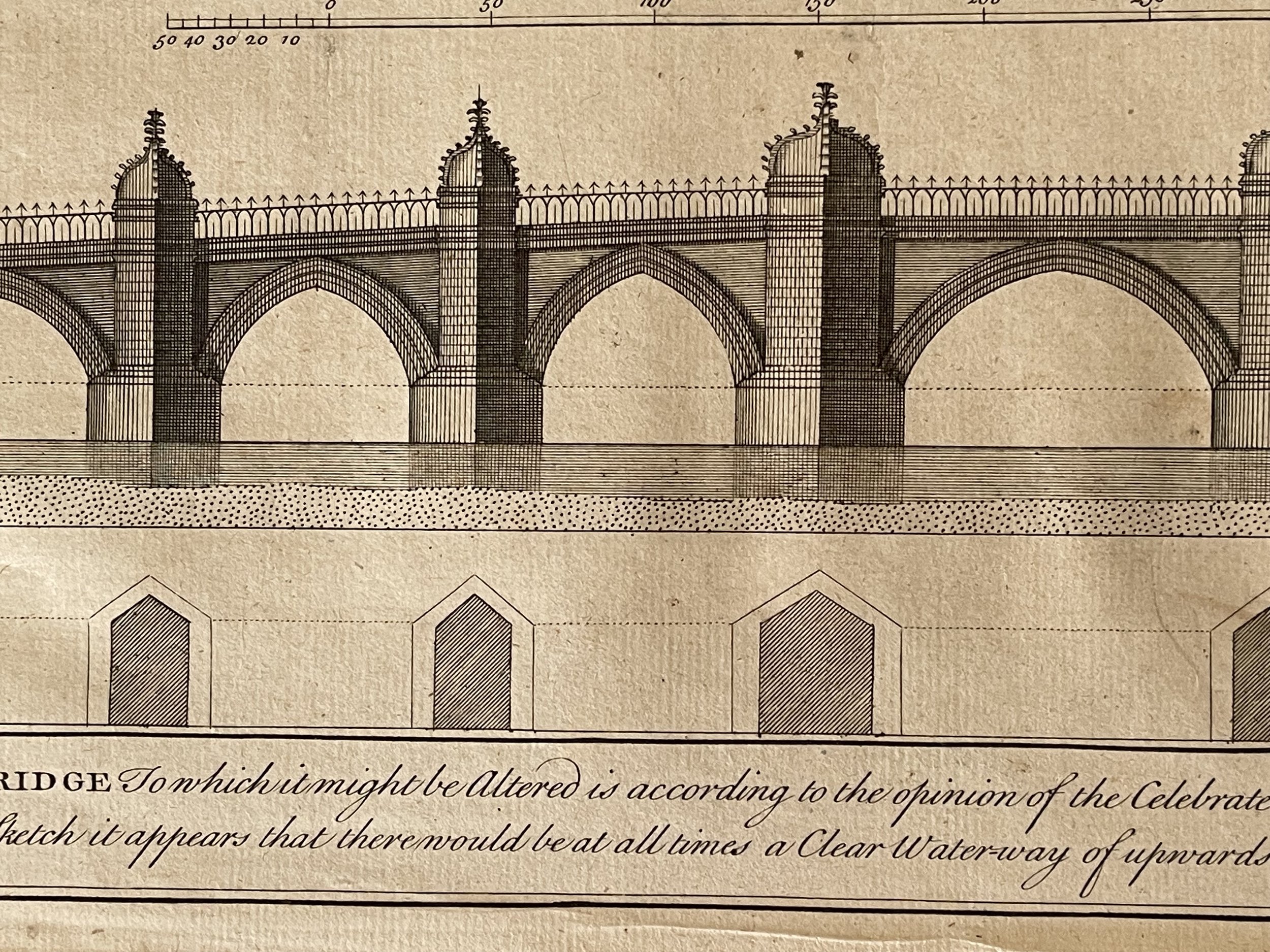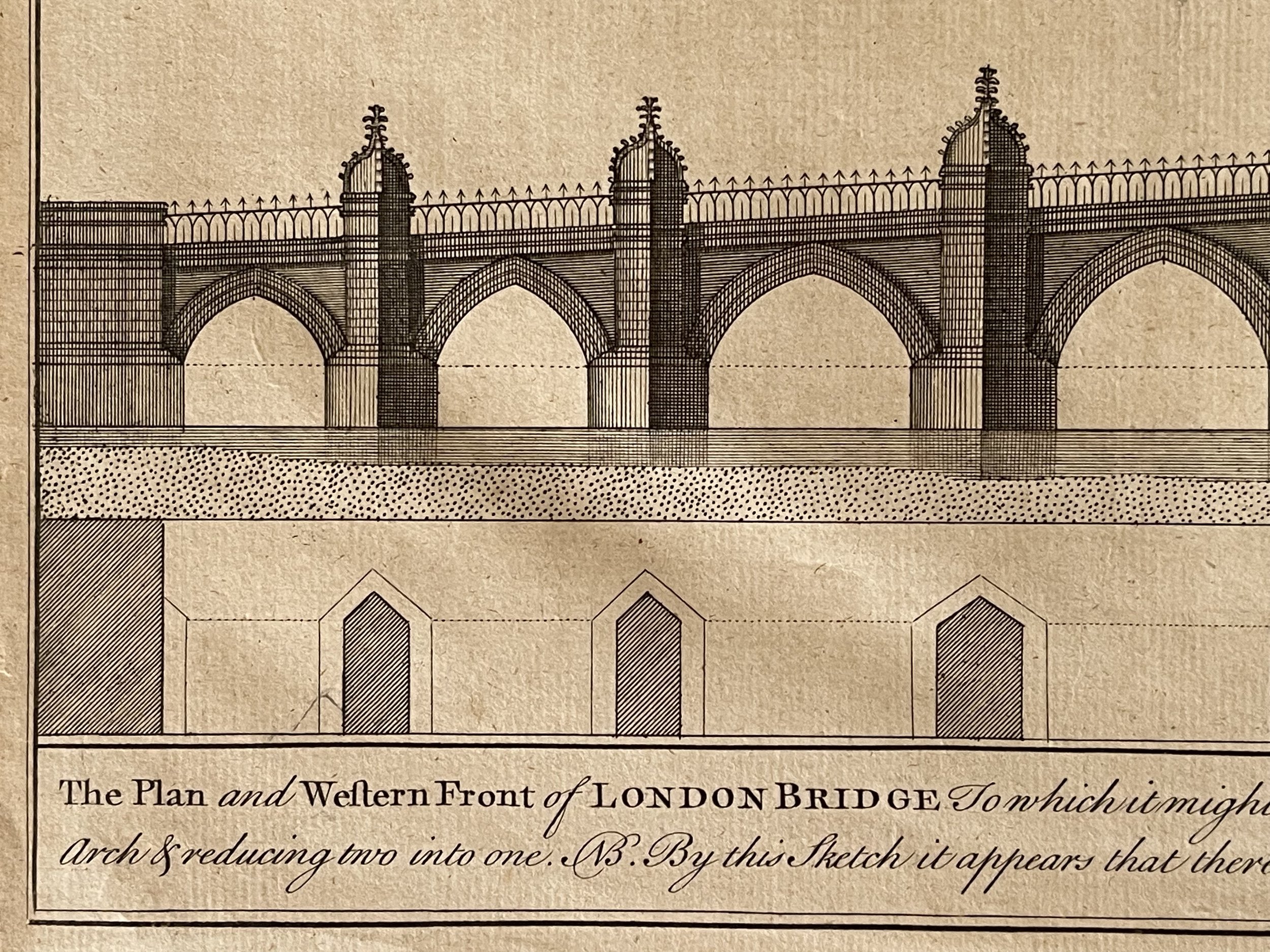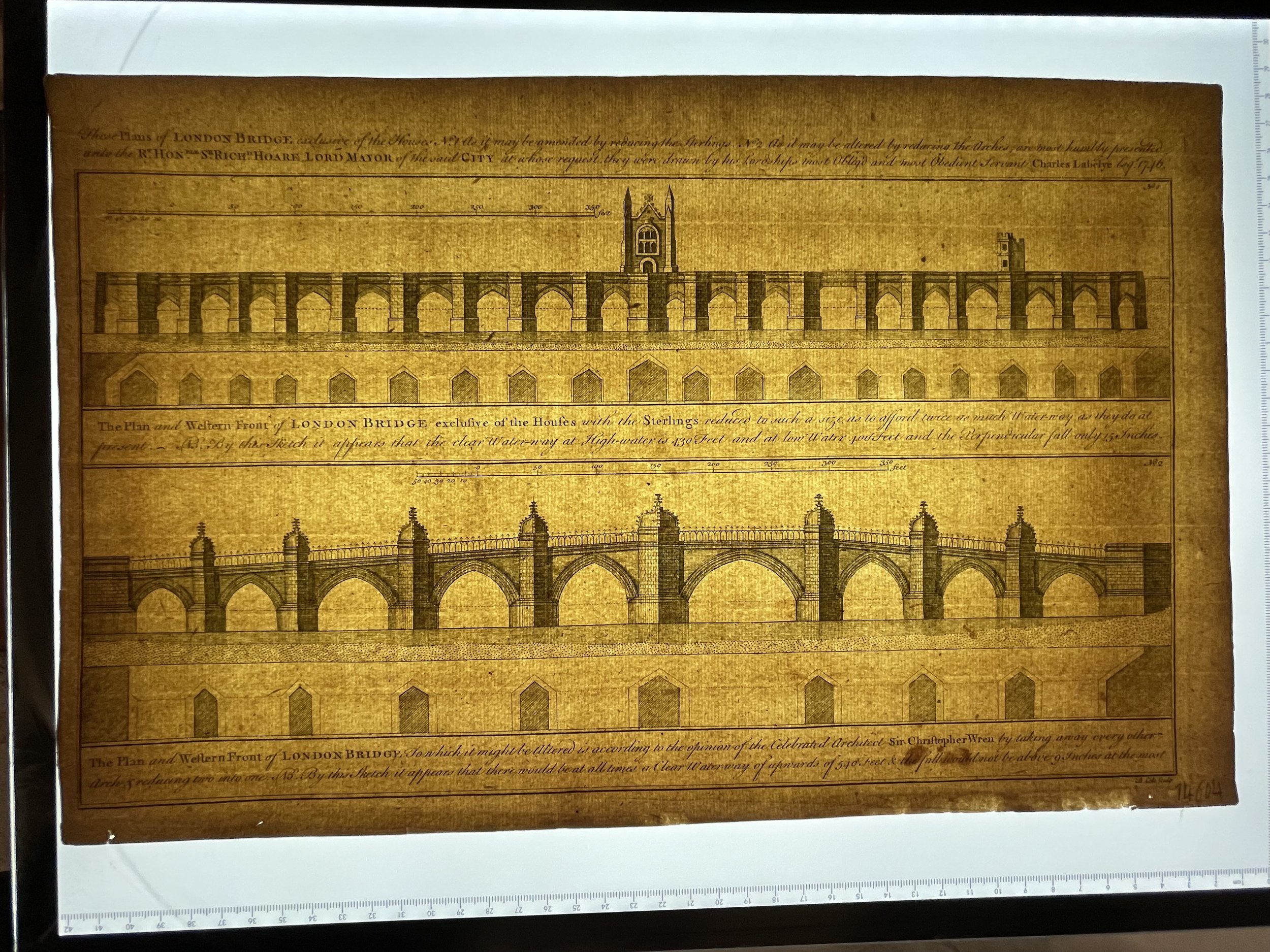Plans for London Bridge - Benjamin Cole / Charles Labelyne- 1746
Engraving by Benjamin Cole of plans submitted by Charles Labelyne for the reconstruction of London Bridge, involving the removal of houses from on top of the bridge as well as reducing the number of arches. Very early engraving showing the plans of London Bridge. The plans were drawn by Charles Labelye in 1746. This engraving, by Benjamin Cole, dates from around 1750. An interesting print.
Working through the eighteenth century, Benjamin Cole was a well-known English engraver, illustrator and map seller. He began as an apprentice in 1739, to his father (also Benjamin), a renowned instrument maker. He went on to draw and engrave the London ward maps for the first edition of William Maitland's History of London from Its Foundation to the Present Time (1769), having already provided them John Entick's New and Accurate History and Survey of London (1766).
These same plates were also used for Thornton's New & Complete History & Survey of London & Westminster, published between 1775-1780. He also engraved maps for some of French map-maker John Rocque’s published works. In 1728-9, given his connections to freemasonry, Cole published a spectacular engraved edition of the historic masonic charters and manuscripts, Old Charges, with various masonic songs and speeches
He later published a separate collection of masonic songs and engraved the frontispiece of the 1756 Book of Constitutions. In 1743, Cole took over the production of the engraved lists from John Pine, continuing their publication until 1767, when the responsibility passed to his brother, William. Benjamin Cole also illustrated children’s books and military manuals, completing a remarkable and varied engraving career. He died in 1813.
Charles Labelye (1705, Vevey, Switzerland – 1762) was a Swiss bridge engineer and mathematician. Moving to England in the 1720s and receiving patronage from the Duke of Bedford and Earl of Pembroke, he is best known there for his work on the original Westminster Bridge (rebuilt in 1854–62) and his invention on that project of caissons as a method of bridge-building. This was praised on its completion, though during the period of construction he received heavy criticism from ill-informed observers, which worsened his health.
Other British projects of his were Brentford Bridge (1740–42), London Bridge (his consultations were sought in 1746 but not acted upon by the corporation of London), designs for a harbour at Sandwich (engraved by Harris about 1740) and reports on the port and harbour facilities at Great Yarmouth (1747) and Sunderland (1748, also with suggested improvements to the River Wear).
A private act of parliament in 1746 (19 Geo. 2. c. 26) naturalised him as a British citizen, but in April 1752 he decided to leave England for southern France. He is known to have been in Naples in 1753, and to have later lived in Paris. In Paris he met and became friends with the fellow bridge-builder Jean-Rodolph Perronnet, bequeathing him papers and a model of Westminster Bridge.
Very good condition with the odd blemish at the footer. Pricing and grading commensurate.
Engraving by Benjamin Cole of plans submitted by Charles Labelyne for the reconstruction of London Bridge, involving the removal of houses from on top of the bridge as well as reducing the number of arches. Very early engraving showing the plans of London Bridge. The plans were drawn by Charles Labelye in 1746. This engraving, by Benjamin Cole, dates from around 1750. An interesting print.
Working through the eighteenth century, Benjamin Cole was a well-known English engraver, illustrator and map seller. He began as an apprentice in 1739, to his father (also Benjamin), a renowned instrument maker. He went on to draw and engrave the London ward maps for the first edition of William Maitland's History of London from Its Foundation to the Present Time (1769), having already provided them John Entick's New and Accurate History and Survey of London (1766).
These same plates were also used for Thornton's New & Complete History & Survey of London & Westminster, published between 1775-1780. He also engraved maps for some of French map-maker John Rocque’s published works. In 1728-9, given his connections to freemasonry, Cole published a spectacular engraved edition of the historic masonic charters and manuscripts, Old Charges, with various masonic songs and speeches
He later published a separate collection of masonic songs and engraved the frontispiece of the 1756 Book of Constitutions. In 1743, Cole took over the production of the engraved lists from John Pine, continuing their publication until 1767, when the responsibility passed to his brother, William. Benjamin Cole also illustrated children’s books and military manuals, completing a remarkable and varied engraving career. He died in 1813.
Charles Labelye (1705, Vevey, Switzerland – 1762) was a Swiss bridge engineer and mathematician. Moving to England in the 1720s and receiving patronage from the Duke of Bedford and Earl of Pembroke, he is best known there for his work on the original Westminster Bridge (rebuilt in 1854–62) and his invention on that project of caissons as a method of bridge-building. This was praised on its completion, though during the period of construction he received heavy criticism from ill-informed observers, which worsened his health.
Other British projects of his were Brentford Bridge (1740–42), London Bridge (his consultations were sought in 1746 but not acted upon by the corporation of London), designs for a harbour at Sandwich (engraved by Harris about 1740) and reports on the port and harbour facilities at Great Yarmouth (1747) and Sunderland (1748, also with suggested improvements to the River Wear).
A private act of parliament in 1746 (19 Geo. 2. c. 26) naturalised him as a British citizen, but in April 1752 he decided to leave England for southern France. He is known to have been in Naples in 1753, and to have later lived in Paris. In Paris he met and became friends with the fellow bridge-builder Jean-Rodolph Perronnet, bequeathing him papers and a model of Westminster Bridge.
Very good condition with the odd blemish at the footer. Pricing and grading commensurate.
Engraving by Benjamin Cole of plans submitted by Charles Labelyne for the reconstruction of London Bridge, involving the removal of houses from on top of the bridge as well as reducing the number of arches. Very early engraving showing the plans of London Bridge. The plans were drawn by Charles Labelye in 1746. This engraving, by Benjamin Cole, dates from around 1750. An interesting print.
Working through the eighteenth century, Benjamin Cole was a well-known English engraver, illustrator and map seller. He began as an apprentice in 1739, to his father (also Benjamin), a renowned instrument maker. He went on to draw and engrave the London ward maps for the first edition of William Maitland's History of London from Its Foundation to the Present Time (1769), having already provided them John Entick's New and Accurate History and Survey of London (1766).
These same plates were also used for Thornton's New & Complete History & Survey of London & Westminster, published between 1775-1780. He also engraved maps for some of French map-maker John Rocque’s published works. In 1728-9, given his connections to freemasonry, Cole published a spectacular engraved edition of the historic masonic charters and manuscripts, Old Charges, with various masonic songs and speeches
He later published a separate collection of masonic songs and engraved the frontispiece of the 1756 Book of Constitutions. In 1743, Cole took over the production of the engraved lists from John Pine, continuing their publication until 1767, when the responsibility passed to his brother, William. Benjamin Cole also illustrated children’s books and military manuals, completing a remarkable and varied engraving career. He died in 1813.
Charles Labelye (1705, Vevey, Switzerland – 1762) was a Swiss bridge engineer and mathematician. Moving to England in the 1720s and receiving patronage from the Duke of Bedford and Earl of Pembroke, he is best known there for his work on the original Westminster Bridge (rebuilt in 1854–62) and his invention on that project of caissons as a method of bridge-building. This was praised on its completion, though during the period of construction he received heavy criticism from ill-informed observers, which worsened his health.
Other British projects of his were Brentford Bridge (1740–42), London Bridge (his consultations were sought in 1746 but not acted upon by the corporation of London), designs for a harbour at Sandwich (engraved by Harris about 1740) and reports on the port and harbour facilities at Great Yarmouth (1747) and Sunderland (1748, also with suggested improvements to the River Wear).
A private act of parliament in 1746 (19 Geo. 2. c. 26) naturalised him as a British citizen, but in April 1752 he decided to leave England for southern France. He is known to have been in Naples in 1753, and to have later lived in Paris. In Paris he met and became friends with the fellow bridge-builder Jean-Rodolph Perronnet, bequeathing him papers and a model of Westminster Bridge.
Very good condition with the odd blemish at the footer. Pricing and grading commensurate.
Code : A299
Cartographer : Cartographer / Engraver / Publisher: Benjamin Cole
Date : Publication Place / Date - Circa 1746
Size : Sheet size: Image Size: 38 x 23 cm
Availability : Available
Type - Genuine - Antique
Grading A-
Where Applicable - Folds as issued. Light box photo shows the folio leaf centre margin hinge ‘glue’, this is not visible otherwise.
Tracked postage, in casement. Please contact me for postal quotation outside of the UK.
